Deep Understanding of Urban Dynamics from Imprint Urban Toponymic Data Using a Spatial–Temporal–Semantic Analysis Approach
Abstract
1. Introduction
2. Related Work
3. Study Area and Data
3.1. Study Drea
3.2. Data
4. Methodology
4.1. Street Name Classification Model
4.2. Kernel Density Estimation
4.3. Featured Functional Area Aggregation
- The center points were extracted from the original street name data organized by line vector.
- The street center points were obtained by using an Aggregate Points Tool with a specific threshold. The experiments found that the threshold value of 3500 meters is appropriate for aggregation of the main categories of the street names. The aggregation results are not too scattered or continuous using this threshold value.
- The aggregation areas were adjusted by buffer. Due to different lengths and shapes of the streets, the point aggregation areas in step 2 could not fully reflect the spatial aggregation status of the same type of street name data. Therefore, we modified the aggregation areas. Taking half of the average length of one type of street name data as the radius, the results from step 2 were analyzed using a buffer in the third step, and the areas intersected by the space were combined in this step. Then, the combined feature areas were finally gathered as featured functional areas.
5. Results
5.1. Classification Results of Street Name Data
5.2. How Street Name Types Change Over Time
5.2.1. The Similarities of Street Names in all Time Periods—The Base Culture of the City
5.2.2. The Differences of Street Names in Each Time Period—The Development Routine of the City
5.3. Spatial Distribution Characteristics of Street Names
5.3.1. The Spatial Distribution Characteristics of Changed Street Names in Each Time Period
5.3.2. The Spatial Distribution Characteristics of All Street Names in the Latest Time Period
5.4. Understanding the City from Place to Location with Semantics
5.4.1. Spatial Distribution Characteristics of Street Names with Different Types
5.4.2. Featured Functional Area Aggregation Results
5.4.3. Discovering City Centers through Street Name Data
6. Discussion
6.1. The Limitation of Street Name Semantic Classification Standard in Research Regions
6.2. The Accuracy of Urban Space Recognition Based on Street Names
7. Conclusions and Future Works
Author Contributions
Funding
Data Availability Statement
Acknowledgments
Conflicts of Interest
References
- Gao, S. Spatio-Temporal Analytics for Exploring Human Mobility Patterns and Urban Dynamics in the Mobile Age. Spat. Cogn. Comput. 2015, 15, 86–114. [Google Scholar] [CrossRef]
- Paez, A.; Scott, D.M. Spatial Statistics for Urban Analysis: A Review of Techniques with Examples. GeoJournal 2004, 61, 53–67. [Google Scholar] [CrossRef]
- Li, S.; Liu, X.; Li, Z.; Wu, Z.; Yan, Z.; Chen, Y.; Gao, F. Spatial and Temporal Dynamics of Urban Expansion along the Guangzhou–Foshan Inter-City Rail Transit Corridor, China. Sustainability 2018, 10, 593. [Google Scholar] [CrossRef]
- Tian, G.; Jiang, J.; Yang, Z.; Zhang, Y. The urban growth, size distribution and spatio-temporal dynamic pattern of the Yangtze River Delta megalopolitan region, China. Ecol. Model. 2011, 222, 865–878. [Google Scholar] [CrossRef]
- Zhang, H.; Ning, X.; Shao, Z.; Wang, H. Spatiotemporal Pattern Analysis of China’s Cities Based on High-Resolution Imagery from 2000 to 2015. ISPRS Int. J. Geo-Inf. 2019, 8, 241. [Google Scholar] [CrossRef]
- Zhang, M.; Du, H.; Mao, F.; Zhou, G.; Li, X.; Dong, L.; Zheng, J.; Zhu, D.; Liu, H.; Huang, Z.; et al. Spatiotemporal Evolution of Urban Expansion Using Landsat Time Series Data and Assessment of Its Influences on Forests. ISPRS Int. J. Geo-Inf. 2020, 9, 64. [Google Scholar] [CrossRef]
- Nassar, A.K.; Blackburn, G.A.; Whyatt, J.D. Developing the desert: The pace and process of urban growth in Dubai. Comput. Environ. Urban Syst. 2014, 45, 50–62. [Google Scholar] [CrossRef]
- Taubenböck, H.; Wegmann, M.; Roth, A.; Mehl, H.; Dech, S. Urbanization in India – Spatiotemporal analysis using remote sensing data. Comput. Environ. Urban Syst. 2009, 33, 179–188. [Google Scholar] [CrossRef]
- Xiao, H.; Liu, Y.; Li, L.; Yu, Z.; Zhang, X. Spatial Variability of Local Rural Landscape Change under Rapid Urbanization in Eastern China. ISPRS Int. J. Geo-Inf. 2018, 7, 231. [Google Scholar] [CrossRef]
- Zhao, M.; Zhou, Y.; Li, X.; Cheng, W.; Zhou, C.; Ma, T.; Li, M.; Huang, K. Mapping urban dynamics (1992–2018) in Southeast Asia using consistent nighttime light data from DMSP and VIIRS. Remote. Sens. Environ. 2020, 248, 111980. [Google Scholar] [CrossRef]
- Li, Q.; Lu, L.; Weng, Q.; Xie, Y.; Guo, H. Monitoring Urban Dynamics in the Southeast U.S.A. Using Time-Series DMSP/OLS Nightlight Imagery. Remote. Sens. 2016, 8, 578. [Google Scholar] [CrossRef]
- Ma, T.; Zhou, Y.; Zhou, C.; Haynie, S.; Pei, T.; Xu, T. Night-time light derived estimation of spatio-temporal characteristics of urbanization dynamics using DMSP/OLS satellite data. Remote. Sens. Environ. 2015, 158, 453–464. [Google Scholar] [CrossRef]
- Zhou, N.; Hubacek, K.; Roberts, M. Analysis of spatial patterns of urban growth across South Asia using DMSP-OLS nighttime lights data. Appl. Geogr. 2015, 63, 292–303. [Google Scholar] [CrossRef]
- Chen, X.; Jian, P.; Yanxu, L.; Yunqian, C.; Tianyi, L. Measurement of Urban Spatial Expansion and Spatial Correlation in Beijing Tianjin Hebei Region Based On DMSP/OLS Night Light Data. Geogr. Res. 2018, 37, 54–65. [Google Scholar]
- Kim, Y.-L. Data-driven approach to characterize urban vitality: How spatiotemporal context dynamically defines Seoul’s nighttime. Int. J. Geogr. Inf. Sci. 2020, 34, 1235–1256. [Google Scholar] [CrossRef]
- Tu, W.; Cao, J.; Yue, Y.; Shaw, S.-L.; Zhou, M.; Wang, Z.; Chang, X.; Xu, Y.; Li, Q. Coupling mobile phone and social media data: A new approach to understanding urban functions and diurnal patterns. Int. J. Geogr. Inf. Sci. 2017, 31, 2331–2358. [Google Scholar] [CrossRef]
- Du, Z.; Zhang, X.; Li, W.; Zhang, F.; Liu, R. A multi-modal transportation data-driven approach to identify urban functional zones: An exploration based on Hangzhou City, China. Trans. GIS 2019, 24, 123–141. [Google Scholar] [CrossRef]
- Zhang, X.; Li, W.; Zhang, F.; Liu, R.; Du, Z. Identifying Urban Functional Zones Using Public Bicycle Rental Records and Point-of-Interest Data. ISPRS Int. J. Geo-Inf. 2018, 7, 459. [Google Scholar] [CrossRef]
- Pei, T.; Sobolevsky, S.; Ratti, C.; Shaw, S.-L.; Li, T.; Zhou, C. A new insight into land use classification based on aggregated mobile phone data. Int. J. Geogr. Inf. Sci. 2014, 28, 1988–2007. [Google Scholar] [CrossRef]
- Steiger, E.; Westerholt, R.; Resch, B.; Zipf, A. Twitter as an indicator for whereabouts of people? Correlating Twitter with UK census data. Comput. Environ. Urban Syst. 2015, 54, 255–265. [Google Scholar] [CrossRef]
- Chu, Y. Basic Course of Toponymy; Surveying and Mapping Press: Beijing, China, 2009. [Google Scholar]
- Hua, L. History of Chinese Place Names; QiLu Press: Jinan, China, 2005. [Google Scholar]
- Conedera, M.; Vassere, S.; Neff, C.; Meurer, M.; Krebs, P. Using Toponymy to Reconstruct Past Land Use: A Case Study of ‘Brüsáda’ (Burn) in Southern Switzerland. J. Hist. Geogr. 2007, 33, 729–748. [Google Scholar] [CrossRef]
- Wang, Y.; Ge, D.; Zhang, T.; Wang, Y. The Sustainable Development of Choronymic Cultural Landscapes in China Based on Geo-Informatic Tupu. Sustainability 2019, 11, 4302. [Google Scholar] [CrossRef]
- Fagúndez, J.; Izco, J. Spatial Analysis of Heath Toponymy in Relation to Present-Day Heathland Distribution. Int. J. Geogr. Inf. Sci. 2016, 30, 51–60. [Google Scholar] [CrossRef]
- Wanjiru, M.W.; Matsubara, K. Street toponymy and the decolonisation of the urban landscape in post-colonial Nairobi. J. Cult. Geogr. 2017, 34, 1–23. [Google Scholar] [CrossRef]
- Light, D.; Nicolae, I.; Suditu, B. Toponymy and the Communist city: Street names in Bucharest, 1948–1965. GeoJournal 2002, 56, 135–144. [Google Scholar] [CrossRef]
- Basik, S. Urban Place Names: Introduction. Urban Sci. 2020, 4, 80. [Google Scholar] [CrossRef]
- Hough, C. The Oxford Handbook of Names and Naming; Oxford University Press: Oxford, UK, 2016. [Google Scholar]
- Jett, S.C. Place-Naming, Environment, and Perception Among the Canyon De Chelly Navajo of Arizona. Prof. Geogr. 1997, 49, 481–493. [Google Scholar] [CrossRef]
- Campbell, J.C. Stream Generic Terms as Indicators of Historical Settlement Patterns. Names J. Onomast. 1991, 39, 333–365. [Google Scholar] [CrossRef]
- Freitas, L.; Afonso, M.J.; Devy-Vareta, N.; Marques, J.M.; Gomes, A.; Chamine, H.I. Coupling Hydrotoponymy and GIS Cartography: A Case Study of Hydrohistorical Issues in Urban Groundwater Systems, Porto, NW Portugal. Geogr. Res. 2014, 52, 182–197. [Google Scholar] [CrossRef]
- Hudson, B.J. The Naming of Waterfalls. Geogr. Res. 2013, 51, 85–93. [Google Scholar] [CrossRef]
- Kitson, P.R. British and European River-Names. Trans. Philol. Soc. 1996, 94, 73–118. [Google Scholar] [CrossRef]
- Nicolae, I. Camino De Santiago: Place Names and Street Names as Border Posts in the Collective Memory. Human Geogr. 2010, 41, 17–31. [Google Scholar]
- Villette, J.; Purves, R.S. From Microtoponyms to Landscape Using Semantics, Location, and Topography: The Case of Wald, Holz, Riet, and Moos in St. Gallen, Switzerland. Prof. Geogr. 2020, 72, 109–120. [Google Scholar] [CrossRef]
- Zhong, A.; Wu, Y.; Nie, K.; Kang, M. Using Local Toponyms to Reconstruct the Historical River Networks in Hubei Province, China. ISPRS Int. J. Geo-Inf. 2020, 9, 318. [Google Scholar] [CrossRef]
- Situ, S.J. Historical Geography Study of Toponyms of Guangdong Province. Essays Chin. Hist. Geogr. 1992, 1, 21–55. [Google Scholar]
- Berg, L.D.; Vuolteenaho, J. Towards Critical Toponymies; Ashgate: Aldershot, UK, 2009. [Google Scholar]
- Berg, L.; Vuolteenaho, J. Critical Toponymies: The Contested Politics of Place Naming; Ashgate: Surrey, UK, 2009. [Google Scholar]
- Tucci, M.; Ronza, R.W.; Giordano, A. Fragments from many pasts: Layering the toponymic tapestry of Milan. J. Hist. Geogr. 2011. [Google Scholar] [CrossRef]
- Zhang, C.; Xiaolin, Z.; Hongbo, L. Research on the Evolution of Urban Road Place Names from the Perspective of Urban Evolution—Taking Nanjing as an Example. Geogr. Geo-Inf. Sci. 2015, 31, 83–88. [Google Scholar]
- Chloupek, B.R. A GIS approach to cultural and historical toponymic research in Nebraska. J. Cult. Geogr. 2018, 35, 23–43. [Google Scholar] [CrossRef]
- Wang, Y.; Wang, Y.; Fang, L.; Ge, D. Spatial-Temporal Characteristics and Causes of Changes to the County-Level Administrative Toponyms Cultural Landscape in the Eastern Plains of China. PLoS ONE 2019, 14, e217381. [Google Scholar] [CrossRef]
- Zhao, F.; Fu, Y.; Luan, G.; Zhang, S.; Cai, J.; Ding, J.; Qian, J.; Xie, Z. Spatial-Temporal Characteristic Analysis of Ethnic Toponyms Based on Spatial Information Entropy at the Rural Level in Northeast China. Entropy 2020, 22, 393. [Google Scholar] [CrossRef]
- Chen, X.; Hu, T.; Ren, F.; Chen, D.; Li, L.; Gao, N. Landscape Analysis of Geographical Names in Hubei Province, China. Entropy 2014, 16, 6313–6337. [Google Scholar] [CrossRef]
- Zhao, B.; Huang, X.; Sui, D.Z. Place Spoofing: A Case Study of the Xenophilic Copycat Community in Beijing, China. Prof. Geogr. 2019, 71, 265–277. [Google Scholar] [CrossRef]
- Hangzhou Civil Affairs Bureau; Hangzhou Toponymy Committee. Hangzhou Gazetteer; Hangzhou Press: Hangzhou, China, 2012. [Google Scholar]
- Bojanowski, P.; Grave, E.; Joulin, A.; Mikolov, T. Enriching Word Vectors with Subword Information. Trans. Assoc. Comput. Linguistics 2017, 5, 135–146. [Google Scholar] [CrossRef]
- Joulin, A.; Grave, E.; Bojanowski, P.; Mikolov, T. Bag of Tricks for Efficient Text Classification. In Proceedings of the 15th Conference of the European Chapter of the Association for Computational Linguistics: Volume 2, Short Papers; Association for Computational Linguistics: Stroudsburg, PA, USA, 2017. [Google Scholar]
- Armand, J.; Grave, E.; Bojanowski, P.; Douze, M.; Jegou, H.; Mikolove, T. Fasttext. Zip: Compressing Text Classification Models. In Proceedings of the 5th International Conference on Learning Representations, Toulon, France, 24–26 April 2017. [Google Scholar]
- Yong, F.; Qu, B.; Xu, H.; Wang, R.; Zhang, Y. Chinese FastText Short Text Classification Method Integrating TF-IDF and LDA. J. Appl. Sci. 2019, 3, 378–388. [Google Scholar]
- Santos, I.; Nedjah, N.; Mourelle, L.D.M. Sentiment analysis using convolutional neural network with fastText embeddings. In Proceedings of the 2017 IEEE Latin American Conference on Computational Intelligence (LA-CCI), Guadalajara, Mexico, 7–9 November 2018. [Google Scholar]
- Alessa, A.; Faezipour, M.; Alhassan, Z. Text Classification of Flu-Related Tweets Using FastText with Sentiment and Keyword Features. In Proceedings of the 2018 IEEE International Conference on Healthcare Informatics (ICHI), New York, NY, USA, 4–7 June 2018. [Google Scholar]
- Wang, G.; Yang, W. Short Text Classification Based On FastText. Electron. Des. Eng. 2020, 28, 104–107. [Google Scholar] [CrossRef]
- Pal, T.; Mahamadi, M.K. An Ecolinguistic Approach Regarding Toponyms in Iran and India. In Proceedings of the National Conference on Regional Dimensions of Social Development in India: Policy Perspectives, Saheed Kshudiram College, Kamakhyaguri, India, 17 February 2017. [Google Scholar]
- Bar-Gal, Y. Cultural-Geographical Aspects of Street Names in the Towns of Israel. Names J. Onomast. 2013, 37, 329–344. [Google Scholar] [CrossRef]
- Zheng, Q. Research on the Cultural Protection of Place Names in Hangzhou in the Process of Urbanization; Zhejiang University: Zhejiang, China, 2011. [Google Scholar]
- Chunliu, L. The study of Geographic Features and Evolution of Urban Placenames in Nanning; Guangxi Teachers Education University: Nanning, China, 2015. [Google Scholar]
- Cui, X.; Wang, J.; Wu, F.; Li, J.; Gong, X.; Zhao, Y.; Zhu, R. Extracting Main Center Pattern from Road Networks Using Density-Based Clustering with Fuzzy Neighborhood. ISPRS Int. J. Geo-Inf. 2019, 8, 238. [Google Scholar] [CrossRef]
- Albuquerque, D.; Dastenaee, M.; Poshtvan, H. Toponyms in ecolinguistics. Contrasts in Different Strategies of Naming Places in Iran and Brazil. Revista de Letras 2018, 37, 148–161. [Google Scholar]
- Light, D.; Young, C. Toponymy as Commodity: Exploring the Economic Dimensions of Urban Place Names. Int. J. Urban Reg. Res. 2015, 39, 435–450. [Google Scholar] [CrossRef]
- Edler, D.; Vetter, M. The Simplicity of Modern Audiovisual Web Cartography: An Example with the Open-Source JavaScript Library leaflet.js. KN J. Cartogr. Geogr. Inf. 2019, 69, 51–62. [Google Scholar] [CrossRef]
- Horbiński, T.; Lorek, D. The use of Leaflet and GeoJSON files for creating the interactive web map of the preindustrial state of the natural environment. J. Spat. Sci. 2020, 65, 1–17. [Google Scholar] [CrossRef]
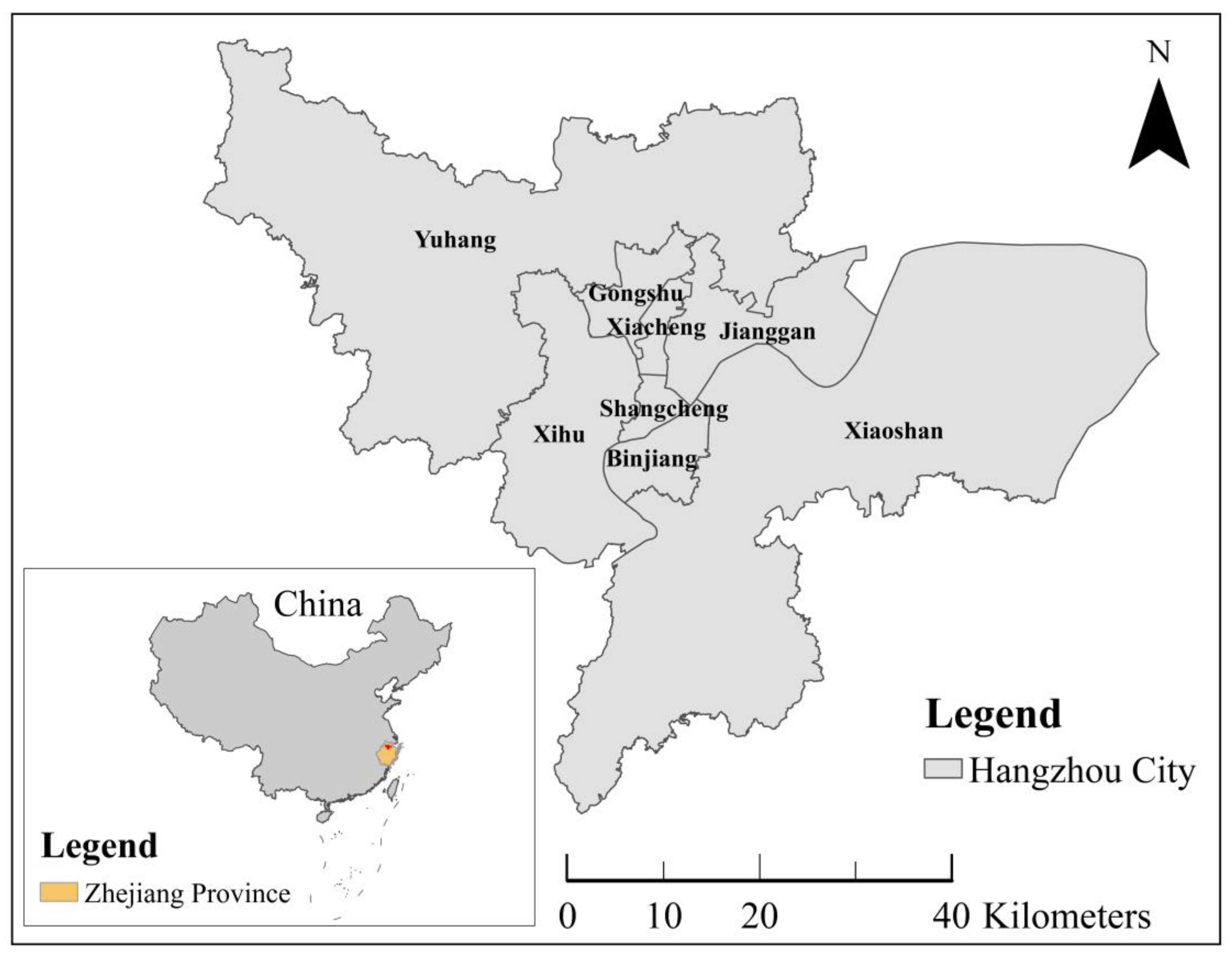

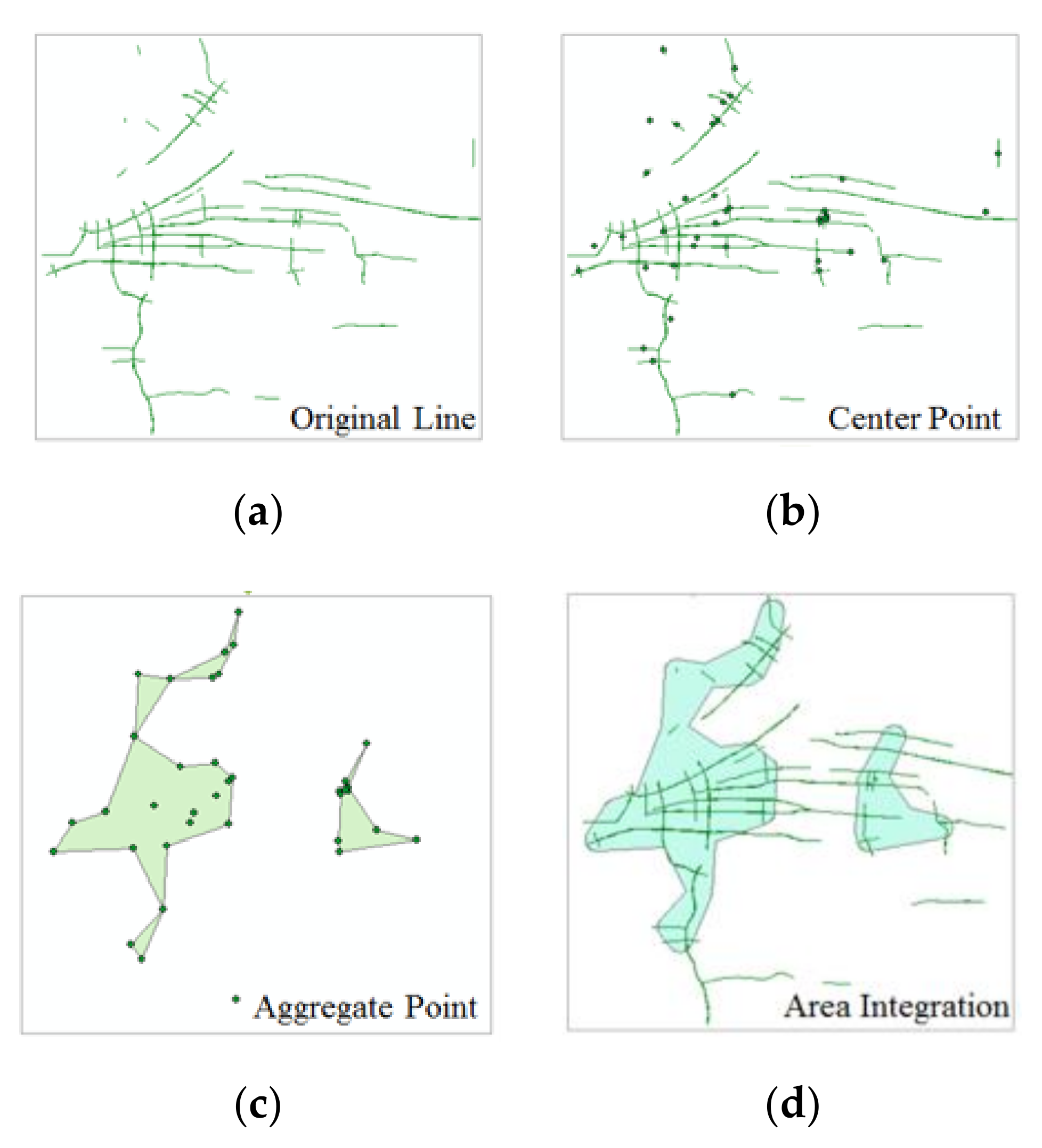
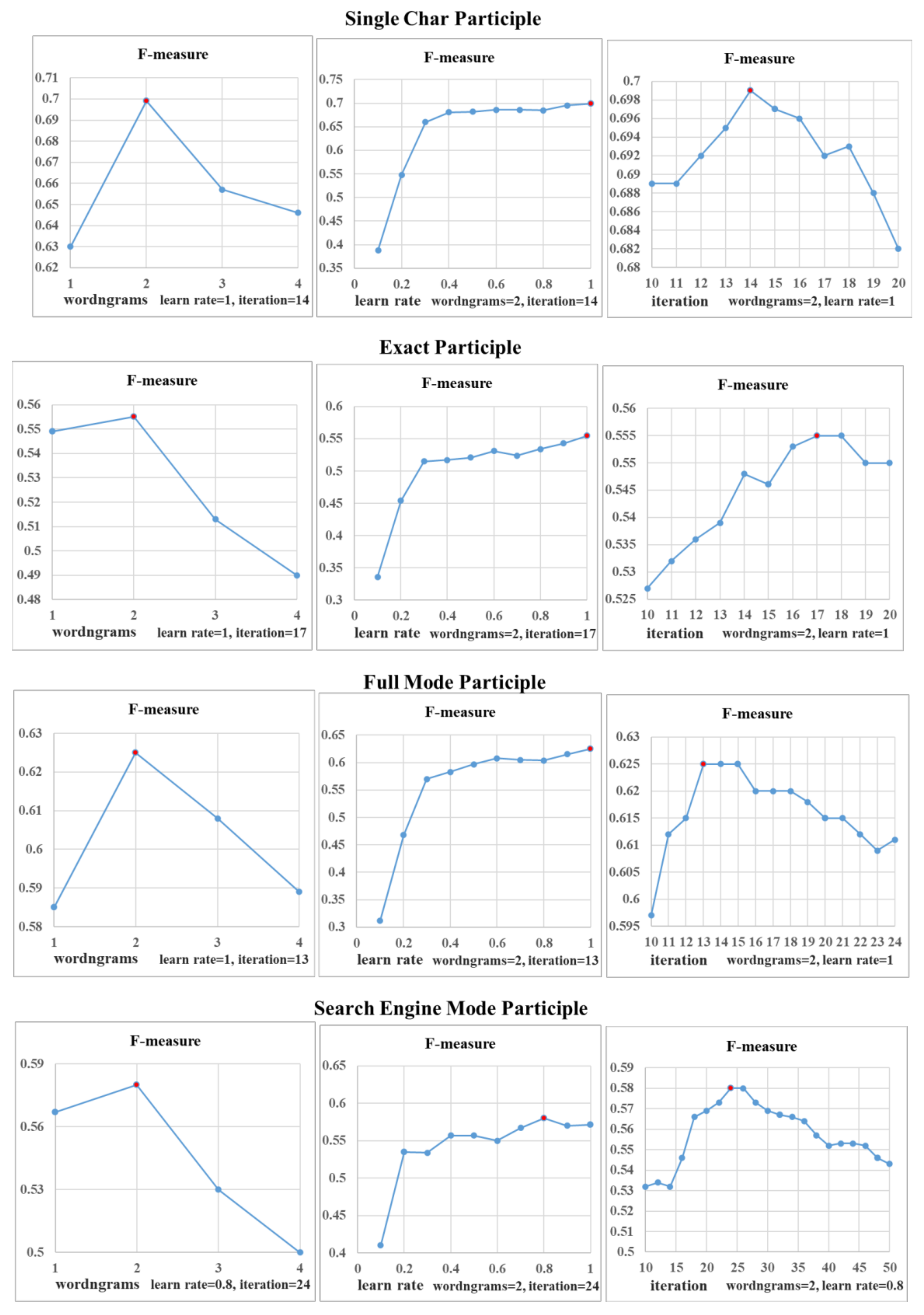
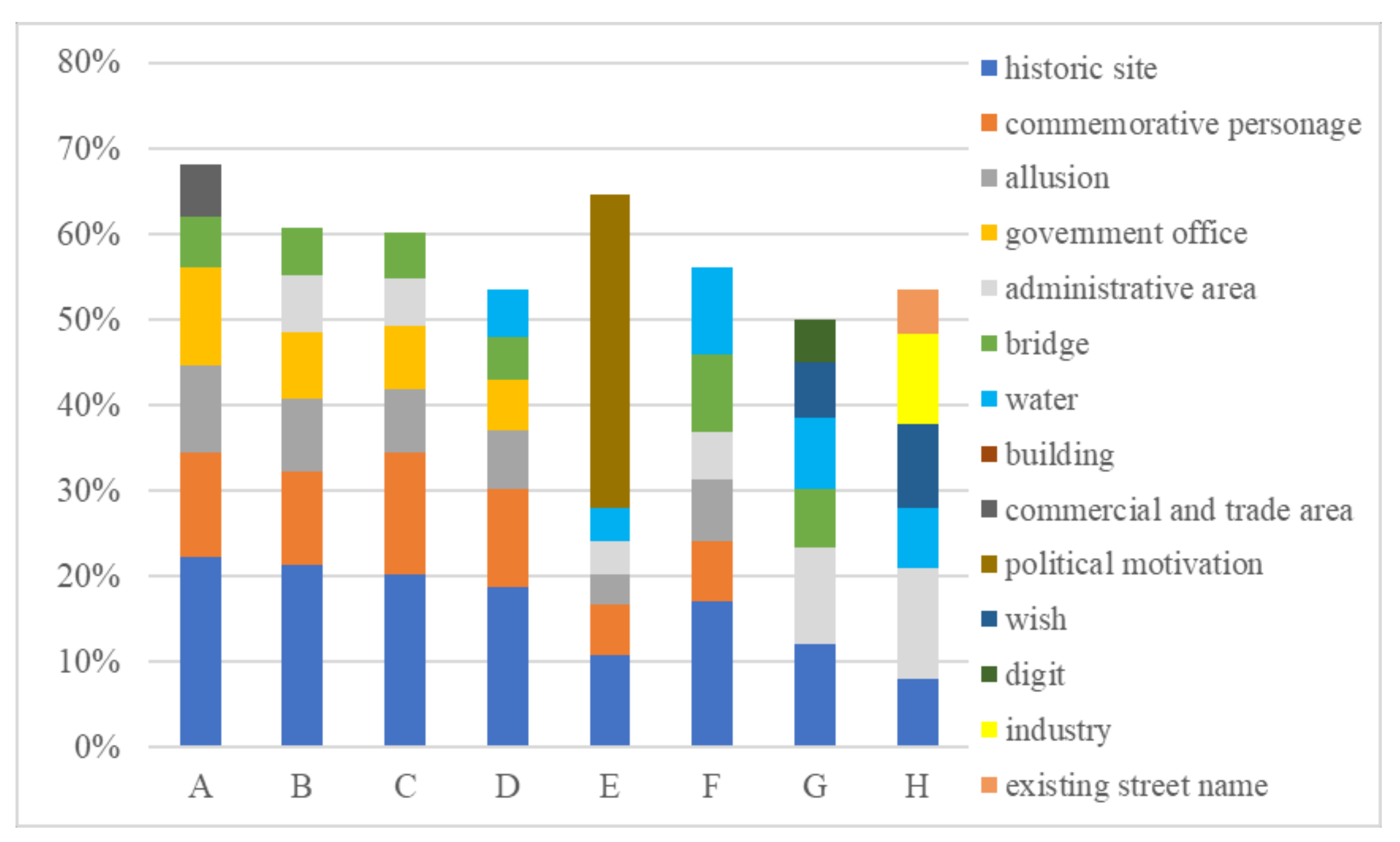
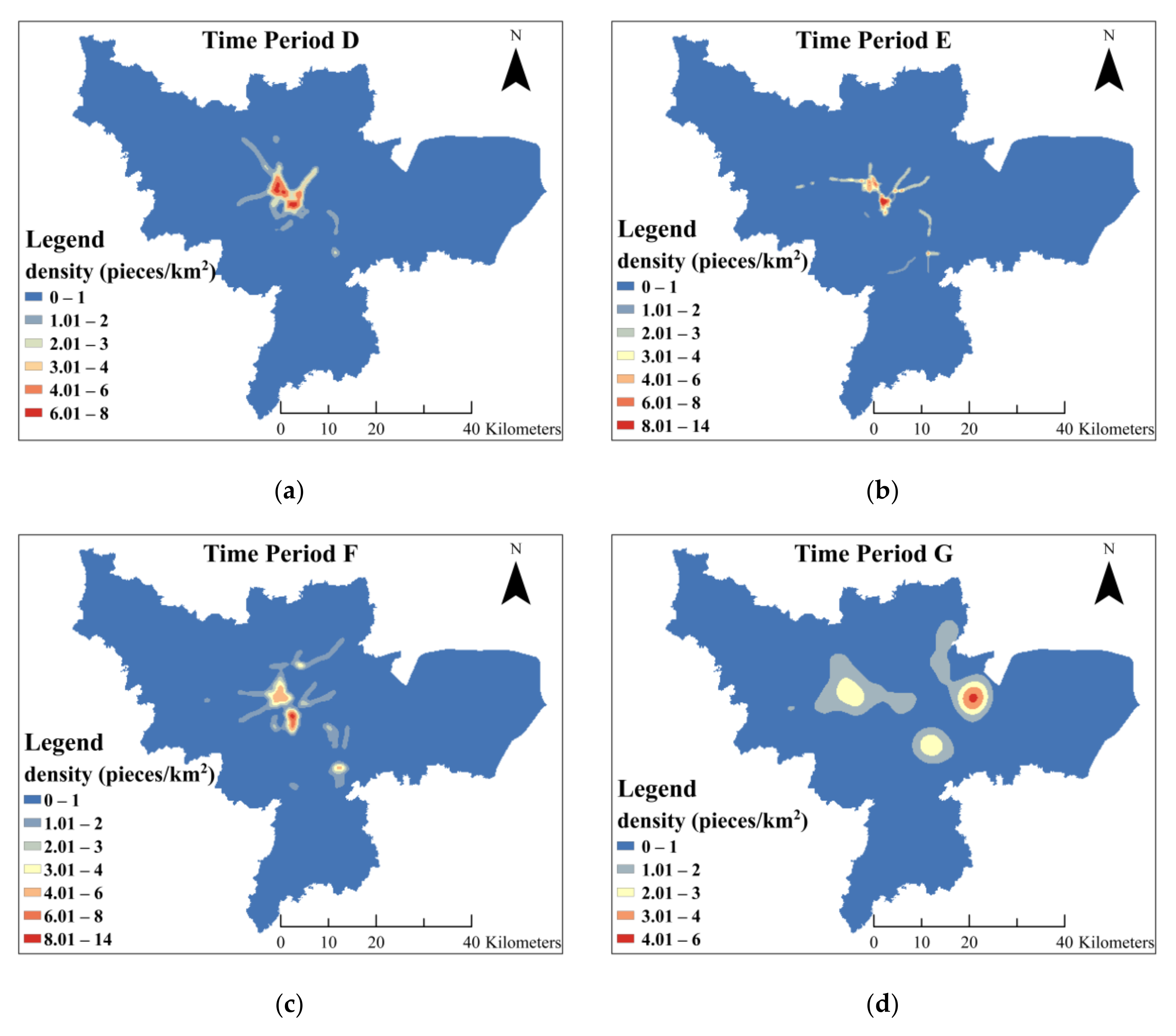
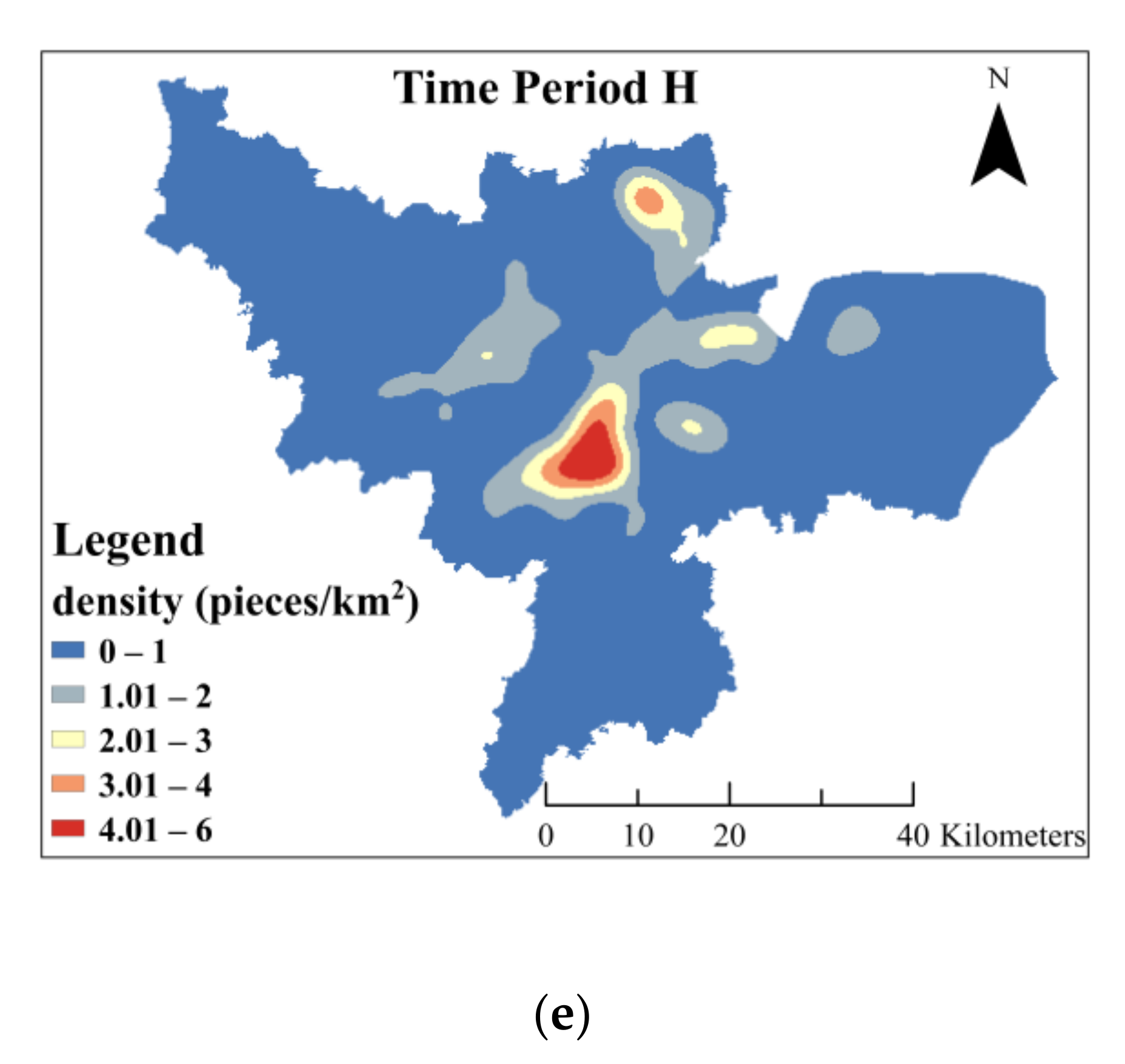
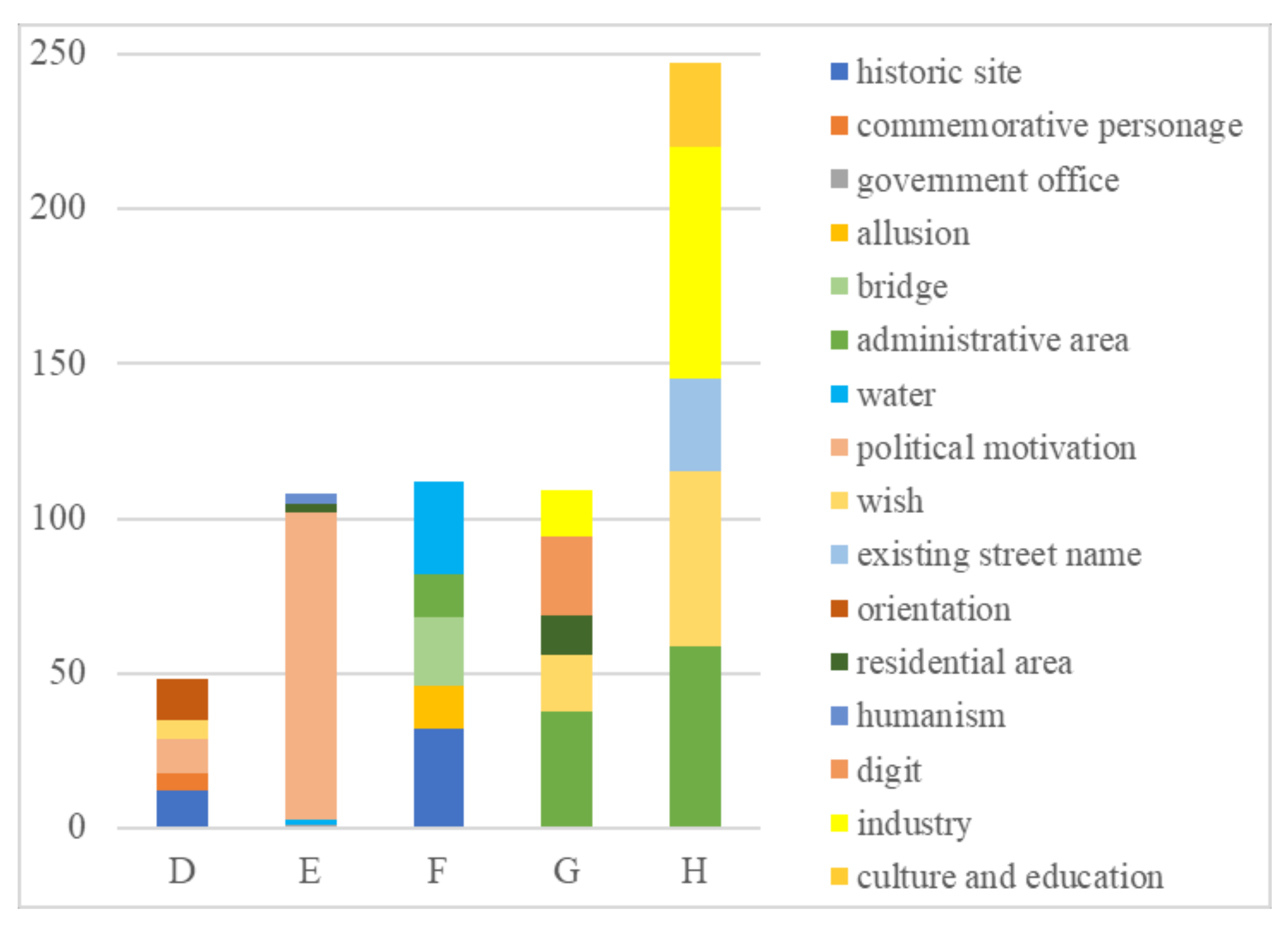

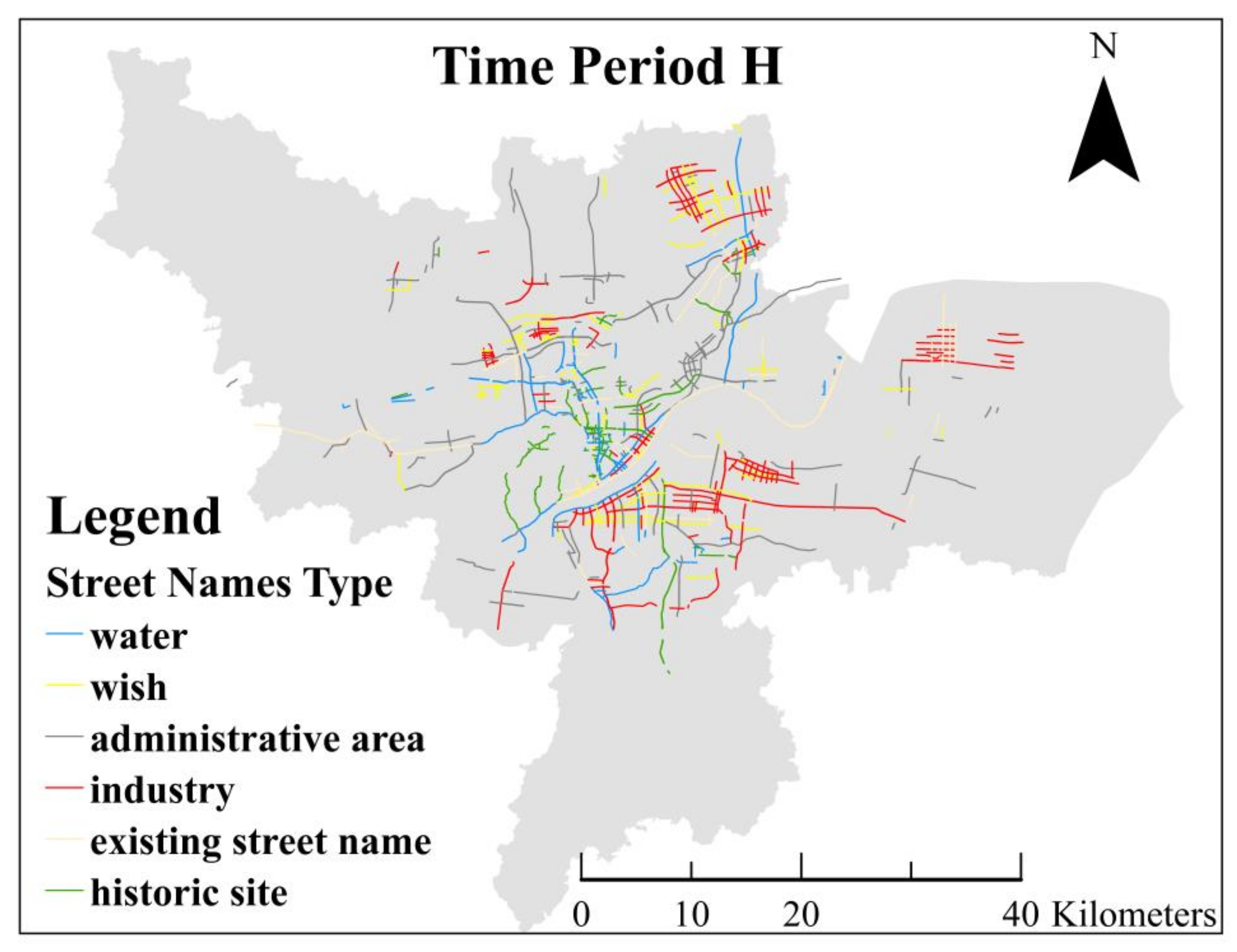



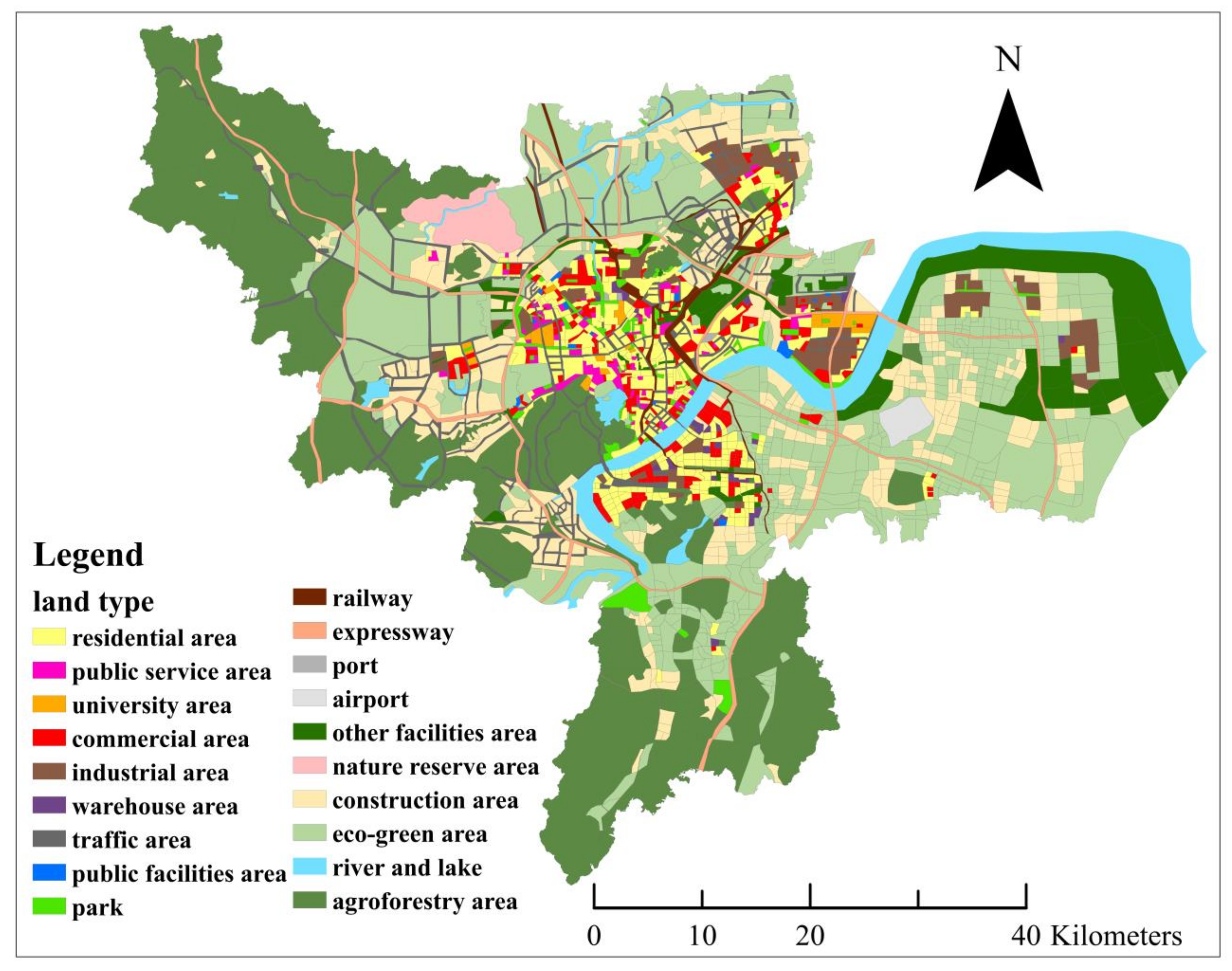
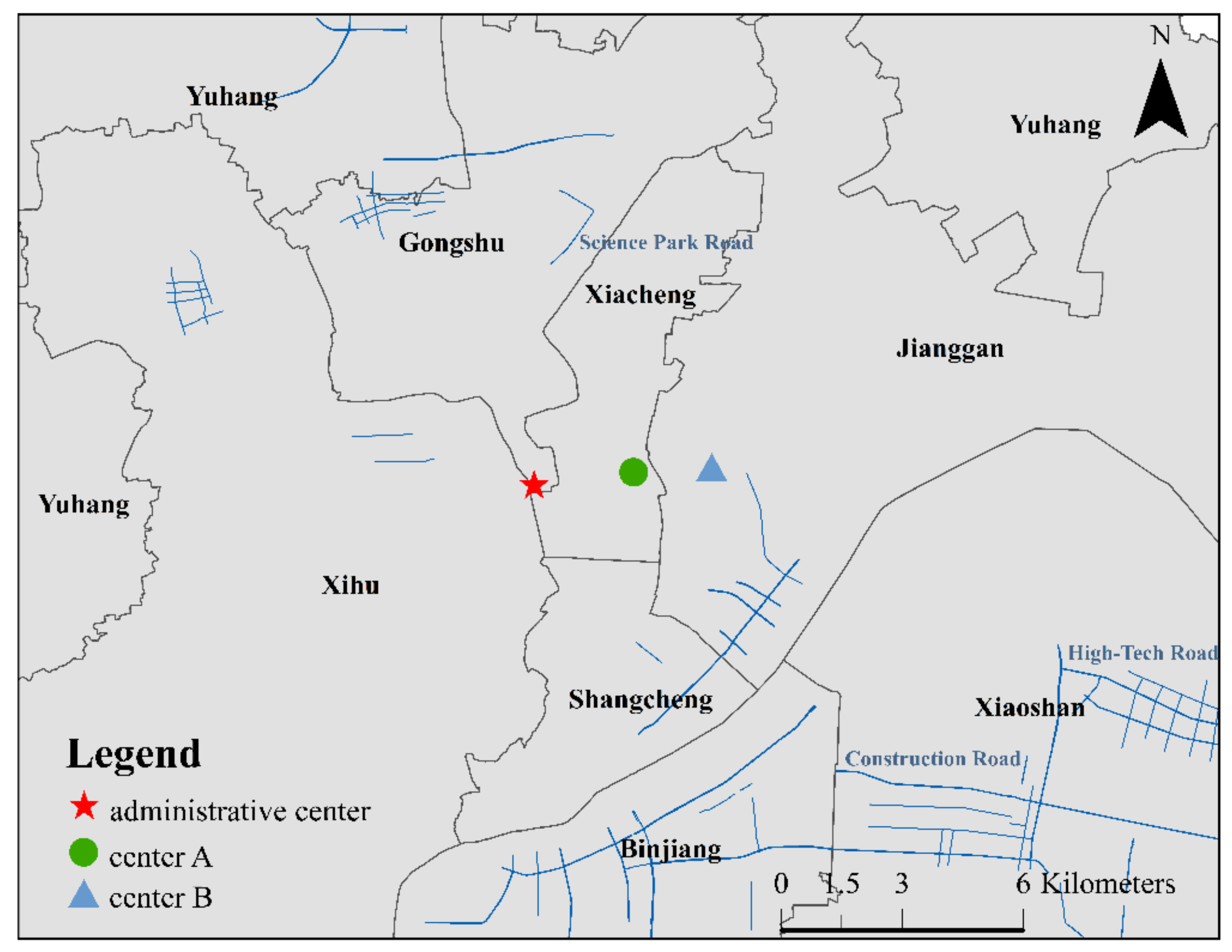
| Time Period | Time Period Name | Year |
|---|---|---|
| A | Qing dynasty and before period | <=1912 |
| B | Republic of China and the Second Sino-Japanese War period | [1913, 1945) |
| C | liberation war period | [1945, 1949) |
| D | early days of the People’s Republic of China founding period | [1949, 1966) |
| E | turbulent development period of the People’s Republic of China | [1966, 1976) |
| F | reform and opening-up period of the People’s Republic of China | [1976, 1990) |
| G | rapid urban sprawl period of the People’s Republic of China | [1990, 2000) |
| H | new millennium development period of the People’s Republic of China | [2000, 2010] |
| Category | Type | Number |
|---|---|---|
| Nature-driven | mountain | 128 |
| water | 254 | |
| orientation | 113 | |
| plant | 52 | |
| animal | 10 | |
| terrestrial material | 16 | |
| scenery | 33 | |
| non-adjacent water | 6 | |
| Society-driven | residential area | 207 |
| building | 133 | |
| bridge | 222 | |
| government office | 87 | |
| commemorative personage | 171 | |
| wish | 364 | |
| allusion | 157 | |
| administrative area | 575 | |
| digit | 31 | |
| industry | 224 | |
| culture and education | 114 | |
| existing street name | 231 | |
| historic site | 284 | |
| political motivation | 237 | |
| sports | 16 | |
| commercial and trade area | 133 | |
| entertainment | 35 | |
| hospital | 11 | |
| humanism | 12 | |
| religion | 3 | |
| environmental protection | 3 | |
| memorial | 2 | |
| non-adjacent administrative area | 21 |
| Street Name Type | Precision Rate | Recall Rate | F-Measure |
|---|---|---|---|
| digit | 1.000 | 1.000 | 1.000 |
| non-adjacent water | 1.000 | 1.000 | 1.000 |
| political motivations | 0.979 | 0.979 | 0.979 |
| bridge | 0.848 | 0.907 | 0.876 |
| non-adjacent administrative area | 1 | 0.75 | 0.857 |
| sports | 0.75 | 1 | 0.857 |
| wish | 0.763 | 0.841 | 0.8 |
| orientation | 0.867 | 0.722 | 0.788 |
| administrative area | 0.76 | 0.807 | 0.783 |
| commemorative personage | 0.765 | 0.788 | 0.776 |
| existing street name | 0.621 | 0.953 | 0.752 |
| culture and education | 1 | 0.6 | 0.75 |
| historic site | 0.737 | 0.737 | 0.737 |
| industry | 0.649 | 0.8 | 0.716 |
| water | 0.692 | 0.735 | 0.713 |
| mountain | 0.667 | 0.75 | 0.706 |
| plant | 0.545 | 0.75 | 0.632 |
| residential area | 0.826 | 0.475 | 0.603 |
| Category | Type |
|---|---|
| Administrative area | Administrative area |
| Scenic area | Mountain |
| Water | |
| Scenery | |
| Historic site | |
| Industry area | Industry |
| Culture and sport area | Culture and education |
| Sport | |
| Wish area | Wish |
| Bridge area | Bridge |
Publisher’s Note: MDPI stays neutral with regard to jurisdictional claims in published maps and institutional affiliations. |
© 2021 by the authors. Licensee MDPI, Basel, Switzerland. This article is an open access article distributed under the terms and conditions of the Creative Commons Attribution (CC BY) license (https://creativecommons.org/licenses/by/4.0/).
Share and Cite
Chen, Y.; Zhang, F.; Li, X.; Zhang, C.; Chen, N.; Du, Z.; Liu, R.; Wang, B. Deep Understanding of Urban Dynamics from Imprint Urban Toponymic Data Using a Spatial–Temporal–Semantic Analysis Approach. ISPRS Int. J. Geo-Inf. 2021, 10, 278. https://doi.org/10.3390/ijgi10050278
Chen Y, Zhang F, Li X, Zhang C, Chen N, Du Z, Liu R, Wang B. Deep Understanding of Urban Dynamics from Imprint Urban Toponymic Data Using a Spatial–Temporal–Semantic Analysis Approach. ISPRS International Journal of Geo-Information. 2021; 10(5):278. https://doi.org/10.3390/ijgi10050278
Chicago/Turabian StyleChen, Yurong, Feng Zhang, Xinba Li, Chuanrong Zhang, Ninghua Chen, Zhenhong Du, Renyi Liu, and Bo Wang. 2021. "Deep Understanding of Urban Dynamics from Imprint Urban Toponymic Data Using a Spatial–Temporal–Semantic Analysis Approach" ISPRS International Journal of Geo-Information 10, no. 5: 278. https://doi.org/10.3390/ijgi10050278
APA StyleChen, Y., Zhang, F., Li, X., Zhang, C., Chen, N., Du, Z., Liu, R., & Wang, B. (2021). Deep Understanding of Urban Dynamics from Imprint Urban Toponymic Data Using a Spatial–Temporal–Semantic Analysis Approach. ISPRS International Journal of Geo-Information, 10(5), 278. https://doi.org/10.3390/ijgi10050278







